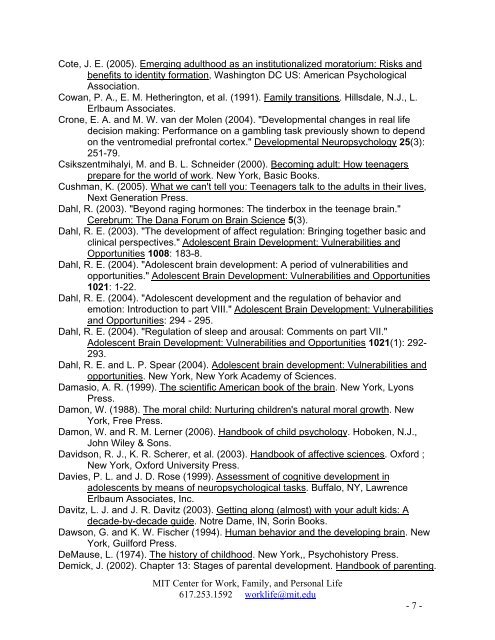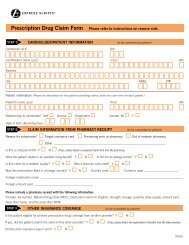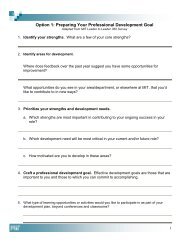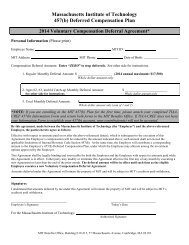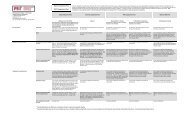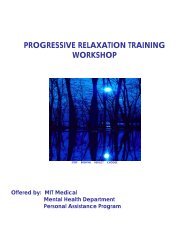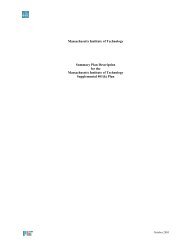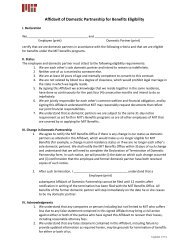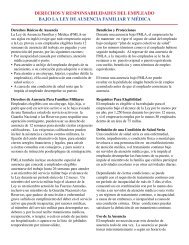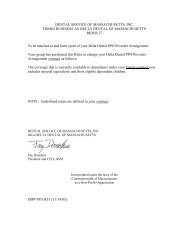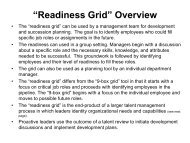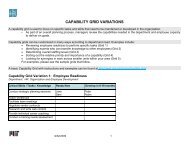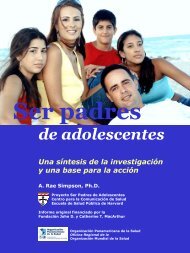Chao, R. K. (2001). "Extending research on the consequences of parenting style <strong>for</strong>Chinese Americans <strong>and</strong> European Americans." Child Development 72(6): 1832-1843.Cheng, D. <strong>and</strong> F. T. L. Leong (1993). "Cultural differences in psychological distressbetween Asian <strong>and</strong> Caucasian American college students." Journal ofMulticultural Counseling & Development 21(3).Chickering, A. W. <strong>and</strong> L. Reisser (1993). Education <strong>and</strong> identity. San Francisco, Jossey-Bass Publishers.Christenson, P. G. <strong>and</strong> D. F. Roberts (1998). It's not only rock & roll: Popular music inthe lives of adolescents. Cresskill, N.J., Hampton Press.Chung, R. H. (2001). "Gender, ethnicity, <strong>and</strong> acculturation in intergenerational conflict ofAsian American college students." Cultural Diversity <strong>and</strong> Ethnic MinorityPsychology 7(4): 376-386.Clayton, R. R. (2004). "The importance of adolescence in the development of nicotinedependence: Introduction to part V." Adolescent Brain Development:Vulnerabilities <strong>and</strong> Opportunities 1021(1): 162-166.Clinchy, B. M. (2002). Revisiting women's ways of knowing. <strong>Personal</strong> epistemology: Thepsychology of beliefs about knowledge <strong>and</strong> knowing. B. K. Hofer <strong>and</strong> P. R.Pintrich. Mahwah, N.J., L. Erlbaum Associates: 63-88.Coburn, K. L. <strong>and</strong> M. L. Treeger (1988). Letting go: A parents' guide to today's collegeexperience. Bethesda, Md., Adler & Adler.Colarusso, C. A. (1992). Child <strong>and</strong> adult development: A psychoanalytic introduction <strong>for</strong>clinicians. New York, Plenum Press.Colby, A., L. Kohlberg, et al. (1983). "A longitudinal study of moral development."Monographs of the Society <strong>for</strong> Research in Child Development 49(2).Coles, R. (1997). The moral intelligence of children. New York, R<strong>and</strong>om House.Coll, C. G. <strong>and</strong> L. M. Pachter (2002). Ethnic <strong>and</strong> minority parenting. Mahwah NJ,Lawrence Erlbaum Associates Publishers.Collins, A. <strong>and</strong> M. van Dulmen (2005). Friendships <strong>and</strong> romance in emerging adulthood:Assessing distinctiveness in close relationships, Washington DC US: AmericanPsychological Association.Commons, M. L., C. Armon, et al. (1990). Adult development: Models <strong>and</strong> methods inthe study of adolescent <strong>and</strong> adult thought. New York, Praeger.Commons, M. L., C. Armon, et al. (1989). A multidomain study of adult development.Adult development : Vol. 1. Comparisons <strong>and</strong> applications of developmentalmodels. New York, NY, Praeger: 33-56.Commons, M. L., F. A. Richards, et al. (1984). Beyond <strong>for</strong>mal operations: Lateadolescent <strong>and</strong> adult cognitive development. New York, Praeger.Constantine, M. G., S. Okazaki, et al. (2004). "Self-concealment, social self-efficacy,acculturative stress, <strong>and</strong> depression in African, Asian, <strong>and</strong> Latin Americaninternational college students." American Journal of Orthopsychiatry 74(3): 230-241.Cooke, M. (2000). Deadly lessons: School shooters tell why. Chicago Sun-Times.Chicago, Illinois.Coontz, S., M. Parson, et al. (1999). American families: A multicultural reader. NewYork, Routledge.<strong>MIT</strong> <strong>Center</strong> <strong>for</strong> <strong>Work</strong>, <strong>Family</strong>, <strong>and</strong> <strong>Personal</strong> <strong>Life</strong><strong>617.253.1592</strong> worklife@mit.edu- 6 -
Cote, J. E. (2005). Emerging adulthood as an institutionalized moratorium: Risks <strong>and</strong>benefits to identity <strong>for</strong>mation, Washington DC US: American PsychologicalAssociation.Cowan, P. A., E. M. Hetherington, et al. (1991). <strong>Family</strong> transitions. Hillsdale, N.J., L.Erlbaum Associates.Crone, E. A. <strong>and</strong> M. W. van der Molen (2004). "Developmental changes in real lifedecision making: Per<strong>for</strong>mance on a gambling task previously shown to dependon the ventromedial prefrontal cortex." Developmental Neuropsychology 25(3):251-79.Csikszentmihalyi, M. <strong>and</strong> B. L. Schneider (2000). Becoming adult: How teenagersprepare <strong>for</strong> the world of work. New York, Basic Books.Cushman, K. (2005). What we can't tell you: Teenagers talk to the adults in their lives,Next Generation Press.Dahl, R. (2003). "Beyond raging hormones: The tinderbox in the teenage brain."Cerebrum: The Dana Forum on Brain Science 5(3).Dahl, R. E. (2003). "The development of affect regulation: Bringing together basic <strong>and</strong>clinical perspectives." Adolescent Brain Development: Vulnerabilities <strong>and</strong>Opportunities 1008: 183-8.Dahl, R. E. (2004). "Adolescent brain development: A period of vulnerabilities <strong>and</strong>opportunities." Adolescent Brain Development: Vulnerabilities <strong>and</strong> Opportunities1021: 1-22.Dahl, R. E. (2004). "Adolescent development <strong>and</strong> the regulation of behavior <strong>and</strong>emotion: Introduction to part VIII." Adolescent Brain Development: Vulnerabilities<strong>and</strong> Opportunities: 294 - 295.Dahl, R. E. (2004). "Regulation of sleep <strong>and</strong> arousal: Comments on part VII."Adolescent Brain Development: Vulnerabilities <strong>and</strong> Opportunities 1021(1): 292-293.Dahl, R. E. <strong>and</strong> L. P. Spear (2004). Adolescent brain development: Vulnerabilities <strong>and</strong>opportunities. New York, New York Academy of Sciences.Damasio, A. R. (1999). The scientific American book of the brain. New York, LyonsPress.Damon, W. (1988). The moral child: Nurturing children's natural moral growth. NewYork, Free Press.Damon, W. <strong>and</strong> R. M. Lerner (2006). H<strong>and</strong>book of child psychology. Hoboken, N.J.,John Wiley & Sons.Davidson, R. J., K. R. Scherer, et al. (2003). H<strong>and</strong>book of affective sciences. Ox<strong>for</strong>d ;New York, Ox<strong>for</strong>d University Press.Davies, P. L. <strong>and</strong> J. D. Rose (1999). Assessment of cognitive development inadolescents by means of neuropsychological tasks. Buffalo, NY, LawrenceErlbaum Associates, Inc.Davitz, L. J. <strong>and</strong> J. R. Davitz (2003). Getting along (almost) with your adult kids: Adecade-by-decade guide. Notre Dame, IN, Sorin Books.Dawson, G. <strong>and</strong> K. W. Fischer (1994). Human behavior <strong>and</strong> the developing brain. NewYork, Guil<strong>for</strong>d Press.DeMause, L. (1974). The history of childhood. New York,, Psychohistory Press.Demick, J. (2002). Chapter 13: Stages of parental development. H<strong>and</strong>book of parenting.<strong>MIT</strong> <strong>Center</strong> <strong>for</strong> <strong>Work</strong>, <strong>Family</strong>, <strong>and</strong> <strong>Personal</strong> <strong>Life</strong><strong>617.253.1592</strong> worklife@mit.edu- 7 -
- Page 1 and 2: MIT Young Adult Development Project
- Page 3 and 4: Barr, C. S., M. L. Schwandt, et al.
- Page 8 and 9: M. H. Bornstein. Mahwah, NJ, Lawren
- Page 10 and 11: orbitofrontal cortex might underlie
- Page 12 and 13: Harkness, S. and C. M. Super (1995)
- Page 14 and 15: on cognition in adolescent tobacco
- Page 16 and 17: of Cognition & Development 1(1): 11
- Page 18 and 19: 70(1): 256-257.Martin, C. A., T. H.
- Page 20 and 21: A. Thompson, A. I. Thompson and J.
- Page 22 and 23: Riera, M. (2003). Staying connected
- Page 24 and 25: adjustment." Personality and Indivi
- Page 26 and 27: Thompson, P. M., J. N. Giedd, et al
- Page 28: Zeigler, D. W. (2004). "The neuroco


